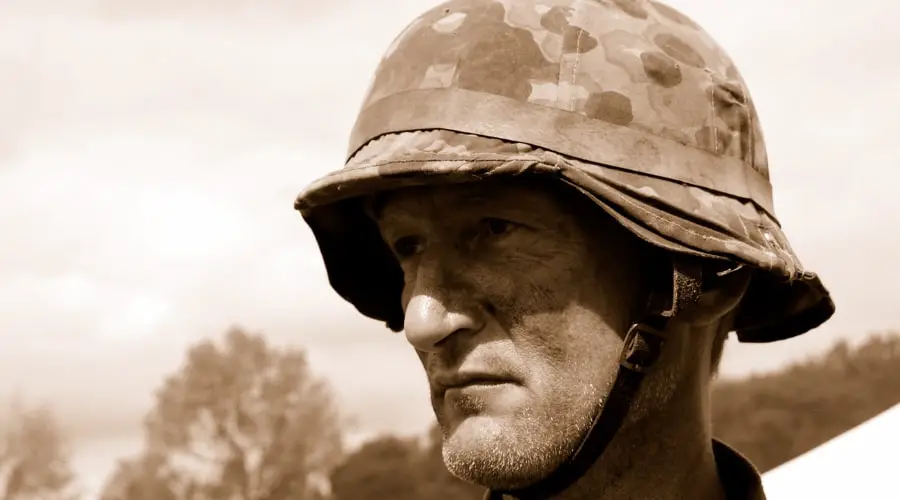Helmets have been used for centuries by soldiers to protect their heads from injury in combat. During World War II, helmets became an essential part of a soldier’s equipment, as the war saw the use of advanced weaponry that was capable of causing severe head injuries.
One of the most commonly asked questions about World War II helmets is whether they were bulletproof or not. In this article, we will explore this question in detail, taking into account the different types of helmets used during the war and the various weapons they were meant to protect against.
The Types of Helmets Used During World War II
Several types of helmets were used during World War II, each designed to protect against specific types of weapons. The most common types of helmets were the M1, the Brodie, and the Stahlhelm.
M1 Helmet
The American military used the M1 helmet during World War II. It was made of two layers of steel and had a removable liner made of fiber or leather. The M1 helmet was designed to protect against shrapnel and debris, but it was not designed to be bulletproof.
Brodie Helmet
The British military used the Brodie helmet during World War II. It was made of a single piece of steel and had a leather chin strap. The Brodie helmet was designed to protect against shrapnel and debris, but like the M1 helmet, it was not bulletproof.
Stahlhelm
The German military used the Stahlhelm during World War II. It was made of a single piece of steel and had a leather chin strap. The Stahlhelm was designed to protect against shrapnel, debris, and bullets. While the Stahlhelm was not completely bulletproof, it was more effective at stopping bullets than the M1 or Brodie helmets.
The Effectiveness of World War II Helmets Against Bullets
While the M1 and Brodie helmets were not designed to be bulletproof, they were effective at protecting against shrapnel and debris. However, they were not effective at stopping bullets. On the other hand, the Stahlhelm was more effective at stopping bullets than the M1 and Brodie helmets. However, it was not completely bulletproof.

However, it’s important to note that no WW2 helmet was completely bulletproof. While the helmets were designed to provide protection against shrapnel and other types of debris, they were not intended to stop a bullet. The helmets were made of steel, which could withstand some degree of impact but were not designed to provide full protection against bullets.
The M1 helmet used by the Allied forces had a thickness of approximately 0.035 inches, which was enough to stop small fragments of shrapnel and debris. However, it was not thick enough to stop a bullet, which could easily penetrate the helmet. The Stahlhelm helmet used by the German forces was slightly thicker, with a thickness of approximately 0.04 inches. While it provided better protection than the M1 helmet, it was still not bulletproof.
It’s also worth noting that the helmets were not designed to provide protection against all types of ammunition. The helmets could withstand the impact of small arms fire, such as pistol rounds and small caliber rifle rounds, but they were not able to stop larger caliber bullets, such as those fired by machine guns or anti-tank rifles.
In summary, WW2 helmets were not bulletproof, and they were not designed to be. They were intended to provide protection against shrapnel, debris, and other projectiles that soldiers may encounter on the battlefield. While the helmets could withstand some degree of impact, they were not able to provide full protection against bullets.
Related: Can a Helmet Stop AK-47 Bullets?
FAQs:
Did any helmets used during World War II offer complete protection against bullets?
No, none of the helmets used during World War II were completely bulletproof.
Did soldiers wear any other equipment to protect themselves from bullets?
Yes, soldiers wore body armor to protect themselves from bullets.
Were there any other factors that could affect the effectiveness of a helmet against bullets?
Yes, the distance from which the bullet was fired, the type of bullet, and the angle at which it hit the helmet could all affect the effectiveness of the helmet against bullets.
Are modern helmets bulletproof?
Yes, modern helmets are designed to be bulletproof and can protect against a wider range of bullets than the helmets used during World War II.
Are there any museums where I can see World War II helmets?
Yes, many museums around the world have collections of World War II helmets on display.
Conclusion
World War II helmets were not designed to be bulletproof. The M1 and Brodie helmets were designed to protect against shrapnel and debris, while the Stahlhelm was designed to protect against shrapnel, debris, and bullets. While the Stahlhelm was more effective at stopping bullets than the M1 and Brodie helmets, it was not completely bulletproof.
Helmetslab is a website that focuses on providing in-depth reviews and information about different types of helmets, including motorcycle helmets and others helmets. I am writing a post with proper research on the info that helps helmet users.

